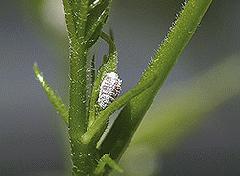Source(s): Jim Howell, Ph.D., Entomologist, The University of Georgia
Citrus Mealybugs
Winter approaches, and with the onset of cooler temperatures, we can finally forget about insect pests until next year. Right? Time for the bugs to either die from the cold, or find some protected retreat until Spring. Or is it?
Some insects thrive indoors and love to take up residence in our homes during the winter months. When we bring our frost-sensitive plants inside, we often times bring in insect pests as well. These insect pests are more than ready to enjoy the protection that our homes provide. One of the most common plant hitchhikers is the citrus mealybug.
Identification
Adult female citrus mealybugs are oval, segmented and about 1/5 inch long, with white, waxy secretions, giving the insects a “mealy” appearance as if covered with fine flour. They also have waxy lateral and terminal filaments of various lengths. Under a hand lens these little sapsuckers look like they’re freshly battered, rolled in flour and ready for the skillet! This “mealy” covering protects the insects from excessive heat and water loss. Mealybugs are usually mobile and may move around very slowly on the stems and leaves of their host plants.
Life History
Citrus mealybugs lay their eggs in a white powdery/waxy mass. An individual may deposit 300 to 600 eggs in this mass and will die soon after the eggs are laid. Time to hatch will vary with temperature, but indoors in a warm environment, the eggs may hatch in as little as one to two weeks. Immature stages develop their powdery covering soon after hatching. They move around on the plant before settling down and are especially active in warm, dry weather. Then, they insert their mouthparts and suck plant juices from their host plant. Population size varies, but under proper conditions, mealybugs can accumulate in large numbers and may kill the plant. This species thrives on a variety of hosts, including but not limited to, African violets, amaryllis, begonias, citrus, coleus, cyclamen, dahlias, dracaenas, ferns, ficus, poinsettias and philodendrons.
Damage
Mealybugs damage their host plants in several ways. Removing sap, or plant juices, weakens the host plant, and the injection of a toxin found in the mealy bug’s saliva is responsible for distortion and yellowing, as well as flower and fruit drop. Mealybugs also produce large amounts of honeydew – a sugary excrement that coats leaves, stems, flowers and fruit. This sugary coating may cause formation of a black sooty mold that degrades the plant’s appearance, and in large quantities can inhibit photosynthesis.
Control
Mealybugs are difficult to control. On houseplants, remove mealybugs with a cotton swab dipped in alcohol or fingernail polish remover. Also, you can wash the insects off in a steady stream of water or wipe them away with a wet cloth. Monitor your plants for a few weeks in case some were missed. Recommended insecticides can also be used to eliminate mealybug infestations; however, heavily infested plants should be discarded.
Resource(s): Insect Pests of Ornamental Plants
Center Publication Number: 231
- Icky Silverfish are Generally Harmless - September 24, 2013
- Menacing Mice - September 24, 2013
- Opossum Damage and Control - September 24, 2013
